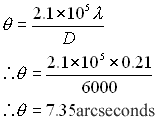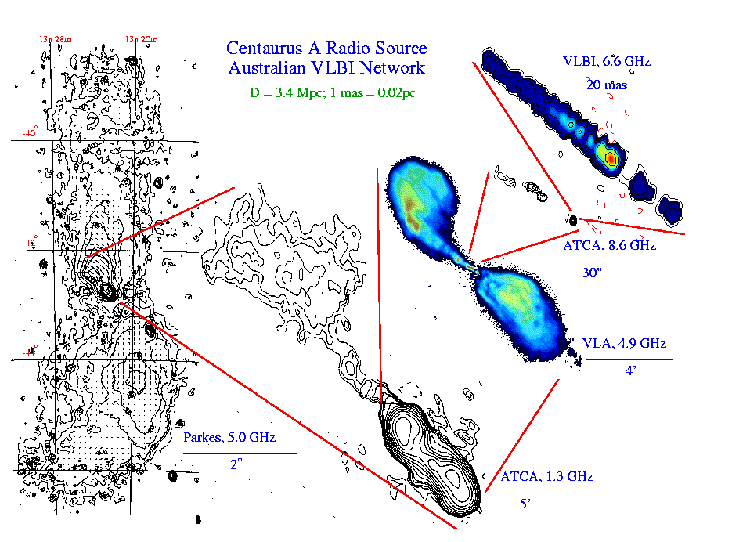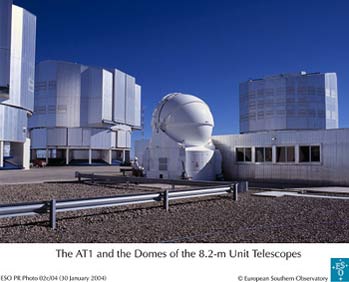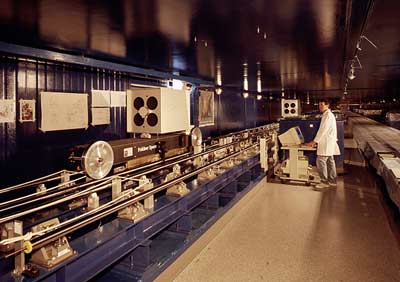Interferometry
Relevant syllabus point:
- outline methods by which the resolution and/or sensitivity of ground-based systems can be improved, including:
- interferometry
Radio Interferometry
Radio astronomers have used the principles of interferometry since the 1960s. Faced with the problem of low spatial resolution when observing at radio wavelengths (remember, θ ∝ λ) one solution was to build larger dishes. Even single dishes such as the 64m Parkes radio telescope, however, only give a resolution of 690 arcseconds (or 11.5 arcminutes, 1/3 size of the Moon) when observing the 21cm hydrogen line. Building even larger dishes imposes engineering and structural problems. The largest steerable single dish telescope is the 100m x 110m GBT in West Virginia, USA. At 305m, the Arecibo telescope is the world's largest dish but it is not steerable, being placed in a doline in the karst region of Puerto Rico. This telescope featured in the films Contact and Goldeneye although it should be stressed that it is not really a lake as portrayed in the James Bond film!
To obtain higher spatial resolution for a given wavelength, radio astronomers applied the technique of interferometry. This involves collecting electromagnetic radiation (eg radio waves) using two or more collectors (eg radio antennae) separated by some distance. In interferometry, the resolution then is not determined by the size of individual collectors such as mirrors or radio dishes but rather by the maximum separation of the collecting elements. ATCA, the Australia Telescope Compact Array, is a radio interferometer that has six-22m dishes. Five of the dishes are on a 3km long wide gauge railway track allowing them to be placed at different stations and separations. The sixth is a further 3 km distance, providing a maximum baseline of 6 km. To see what configuration ATCA is currently in and observing go to ATCA Live!

What resolution can ATCA achieve for the 21cm hydrogen line?

As you can see, this is still lower than what is achievable for ground-based optical astronomy. Fortunately astronomers can also link up telescopes over longer baselines by recording the data with an accurate time base and correlating the data later. This technique is called very long baseline interferometry or VLBI. ATCA can be linked with the 22m dish at Mopra, the 64m Parkes radio telescope and dishes at Tidbinbilla near Canberra, Hobart and Ceduna in South Australia to simulate a telescope with a baseline of 1,703 km. Australian dishes can also be linked with radio telescopes in Japan, Hawaii and even Hartebeesthoek in South Africa, giving a baseline of 9,847 km. Until recently ATNF telescopes were sometimes linked with the 8m Japanese VSOP satellite (VLBI Space Observatory Programme) to achieve VLBI baselines up to 21,000 km from its highly elliptical orbit. A useful outline of interferometry and VLBI can be found here.
Using VLBI, radio astronomers can achieve spatial resolutions in the milli-arscecond range, higher than that currently obtainable by optical telescopes. The image below shows the radio galaxy, Centaurus A (or NGC 5128) as imaged by radio telescopes at various frequencies. Each successive image to the right shows increasing details and is at higher resolution than the preceding one. The images range from the left hand one by the 64m Parkes radio telescope (a single dish), to the 6km ATCA, the 36km VLA in Socorro, New Mexico and finally a VLBI image, all of which used interferometry. VLBI allows astronomers to probe the very core of Active galactic Nuclei such as Cen A.

Increasing the baseline length improves the resolution an interferometer can achieve. The sensitivity, however, is still a function of the total collecting area. This means that the Australia Telescope Compact Array, with a 6km baseline can achieve a higher resolution than the 305m Arecibo dish but the Arecibo dish will be far more sensitive than the combined six 22m dishes of ATCA as it has a much greater surface area.
Optical Interferometry
Early Pioneers
The American physicist, A. A. Michelson (of Michelson-Morley fame) suggested in 1890 that the diameters of stars could be measured using an optical interferometer. He used the technique to measure the diameter of the Galilean moons of Jupiter but is was not until 1920 that J. A. Anderson and F. G. Pease, using a Michelson stellar interferometer on the new 100 inch Hooker telescope on Mount Wilson, succeeded in measuring some stellar diameters. They obtained values of 0.056 arcseconds for Mira, 0.047 arcseconds for Betelgeuse and 0.040 arcseconds for Antares. Given the then known distances to the stars this meant that Mira and Betelgeuse were about 300 times the size of the Sun and Antares 450 times. This stunning result confirmed the existence of giant and supergiant stars that had been earlier proposed by Hertzsprung and Russell.
In 1956, the British radio astronomer, Robert Hanbury Brown developed the intensity interferometer that was used to measure the size of radio stars. His radio observations of Cygnus A allowed it to be matched with its optical component, the first time this was achieved for a radio source. After moving to Australia in 1962 he built an optical large mirror intensity interferometer at Narrabri and over the next two decades built up a detailed catalogue of the size of hotter stars.
Modern Optical Interferometers
The field of optical interferometry was regarded as a more difficult than radio interferometry and limited in application until recently. The key difference is that as the wavelength of the visible light is much smaller than that of radio waves, the precision required in the optical path is much higher. Cumulative errors of less than a micron in the optical path of the interferometer can render observations useless. The optical and engineering requirements for a functioning optical interferometer are exacting and still being refined.
Australia has been a pioneer in the renewal of optical interferometry. The Sydney University Stellar Interferometer, SUSI, opened in 1991 at Narrabri near the Australia Telescope Compact Array continues to be developed. Ultimately it will allow observations of bright stars to be made from a 640m baseline and is currently operating out to 80m. The focus of its observations is on improving our understanding of stellar astrophysics including: Single stars (measuring effective temperatures, radii and luminosities), binary stars - (as for single stars, plus measuring distances and masses), variable stars (e.g. Cepheids and Miras) and emission line stars (e.g. Be and Wolf-Rayet stars). A detailed explanation of stellar interferometry, the astronomy and how it works can be found on the SUSI website.

Optical interferometers are also being developed for the largest telescopes currently operating. The twin 10m Keck telescopes are being linked to form an interferometer. Even more powerful is the Very Large Telescope Interferometer which will link the four VLT 8.2m telescopes with four moveable 1.8m Auxiliary Telescopes. Once fully operational, the VLTI will provide both a high sensitivity as well as milli-arcsecond angular resolution provided by baselines of up to 200m length. Already this instrument is producing some exciting science including the discovery that the fast spinning hot star Achernar has an equatorial radius more than 50% larger than its polar axis making it the flattest star known and detailed observations of the elongated wind emitting from the highly unstable star, Eta Carinae.
The Future
As with most other branches of observational astronomy, plans are underway to extend the capabilities of optical interferometry through space-based missions. NASA is developing the Space Interferometry Mission, SIM, due for launch in 2009. It will measure the position of stars using parallax to an accuracy of 4 micro-arcsecond. This accuracy will enable SIM to determine stellar distances to 10 percent accuracy out to a distance of 25,000 parsecs.
Physicists are applying interferometric techniques using lasers on long baselines in the hope of detecting predicted gravity waves from celestial objects and events. As yet, these extremely weak non-electromagnetic waves have never been detected but their existence is predicted by General Relativity. Two facilities, at Washington and Louisiana in the USA form LIGO, the Laser Interferometer Gravitational Wave Observatory. Australia's research effort in concentrated in Western Australia at AIGO, the Australian International Gravity Observatory. The detection of gravity waves would be an important discovery and help us refine our theories of relativity and cosmology.
Further Information
Astronomical interferometry, from the visible to sub-mm waves gives a useful overview of the topic with some mathematics and detail.
Astronomical Optical Interferometry is a detailed, technical site with numerous links to other interferometry pages. It provides some useful diagrams and a wealth of history and theory.
ATCA Live! provides real time updates about the six 22-m dishes of the Australia Telescope Compact Array radio telescope at Narrabri in northern NSW. Although a radio rather than an optical interferometer, it serves as a useful comparison . Introduction to Radio Astronomy and Interferometry has a concise explanation of how radio interferometry operates. (ATNF site)
MWO – An Introduction to Interferometry is a useful article from the Mount Wilson Observatory covering the basic idea of wave interference, the Michelson-Morely experiment and the application of interferometry to astronomy. This brief article would also be useful for module 9.2 Space.
OLBIN Links is a NASA site providing information on all optical long baseline interferometry projects, both ground-based and space-based.
Planet Quest: Mission - SIM gives details about the next generation in optical interferometry; NASA's planned Space Interferometry Mission, scheduled for launch in 2009. It also has details on Michelson and his interferometer including a virtual interferometer that allows you to simulate the Michelson-Morley experiment.
SUSI Home Page is the site for the Sydney University Stellar Interferometer, a 640m baseline optical interferometer at Narrabri, NSW built and run by the Institute of Astronomy. The site has brief but clear pages such as What is stellar interferometry? that are at an appropriate depth for students.
The Very Large Telescope Interferometer provides details about this exciting and powerful instrument.
What is an Optical Interferometer? has a number of experts responding to this question on the Scientific American website.
Questions
- What effect does increasing the baseline length have on the achievable resolution of an interferometer?
- Why is interferometry such an important technique for radio astronomers?
- Compare the theoretical resolution for a single 22m dish of ATCA with that achieved by the six dishes operating on a 6km baseline at 8.6GHz.
- At which frequency, 1.4GHz, 8.6 GHz or 23GHz would the Compact Array achieve highest resolution?
- What effect does increasing the baseline length of the Compact Array have on its sensitivity?
- Explain why it is harder for to build an interferometer on optical telescopes than radio telescopes.
- Why must the light travelling along the baseline in SUSI travel in an evacuated tube?
- Outline some of the observations suited to modern optical interferometers.
- What would the theoretical resolution of the VLTI operating on at 200m baseline at 400nm be?


